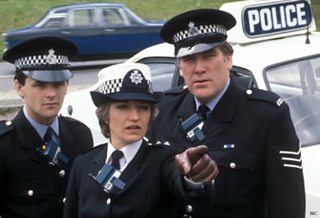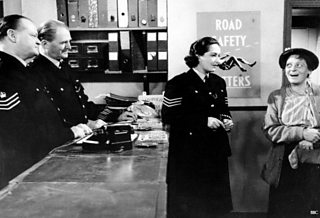
Stephanie Turner as Inspector Jean Darblay in a scene from series 2 of Juliet Bravo, with Gerard Kelly and David Ellison
ITV tonight launches a new drama series - or rather a variation on a long-established one - Prime Suspect 1973. Written as ever by Lynda la Plante, although in this case adapted by Glen Laker from her novel Tennison, it explores the origins of her central character Jane Tennison who appeared in successive series of Prime Suspect from 1991 onward.
Jane Tennison was an innovative character, a hard-working and hard-drinking detective succeeding in her profession despite the attitudes of her male colleagues. Her original portrayal was a classic performance by , that led to her career reaching its current heights as a major film star.
Like their real-life counterparts, it took many years before female police characters were taken seriously, and given equal prominence in crime dramas. Until 1980 there was no series built around a woman police character in the UK, although American television had pioneered the genre with the Angie Dickinson series Police Woman (1974-78). US TV would also innovate with the much-loved female buddy series (1981-88).
In the earliest police series like Dixon of Dock Green and Z Cars, there was usually at least one regular policewoman character, but as in reality they were usually confined to dealing with the problems of other women and with children, as female police officers were part of a separate women’s division. Dixon of Dock Green had the motherly and sensible , from its second series in 1956 until the end of 1961.
, ironically, as supposedly the more advanced series, had very little for their WPC characters to do. In the 1960s WPC Jenny Stacey (Lynne Furlong) was involved in a number of early storylines, but was gradually phased out. The 1970s incarnation of the show had policewomen played by, among others, and , but the emphasis overall was on their male counterparts. No other police drama of the time broke this formula in any meaningful way.
The ITV series The Sweeney advanced the style of television police series, but its aggressive tough guy characters did not provide a welcoming environment for female police officers. Its �������� equivalent, , did at least feature a female detective, Vivien Heilbron’s Det-Sgt Louise Colbert, and there were more prominent roles for women characters in the quirky ITV drama Strangers (1978-82).

Station Sergeant Flint and PC Dixon keep safely behind the desk in Dock Green nick, while Woman Sergeant Millard (Moira Mannion) deals with a tricky customer.
In 1980, a brace of police dramas were launched which at last featured female leads. The Gentle Touch was the first, a series that showed a female detective inspector, Maggie Forbes (Jill Gascoigne), tackling the kind of crimes other series had left to men to solve.
Later the same year the �������� weighed in with , which perhaps caught the public imagination more (though there was enduring confusion for some people who not unnaturally assumed that the title was the main character's name). It lasted for six series, three each with two different female uniformed Inspectors in charge of the police station in the small Lancashire town of Hartley. Supported by their two sergeants and a small group of PCs, both faced up to the sexism of the police service in their own way, gradually overcoming its conservative attitudes.
The first of the two was Inspector Jean Darblay, played by Stephanie Turner. She had prior form in the genre, both in , as mentioned above, and in The Sweeney as the ill-fated wife of Dennis Waterman’s Sergeant Carter. Despite their prominent roles, both lead characters were still defined by their relationships with men. Darblay was married to a social worker (David Hargreaves), while her successor (Anna Carteret), was single, but had a will-they/won’t-they relationship with another senior officer, DCI Mark Perrin, played by Edward Peel.
In the 2000s, the linked series and gave satirical comment on 70s/80s attitudes, and on cop shows of those eras. In the former, the main female recurring character is WPC Annie Cartwright, who puts up with the Neanderthal attitudes of male officers. In Ashes to Ashes, Keeley Hawes took the main role of Alex Drake, replacing John Simm’s Sam Tyler in the previous series.
Meanwhile in dramas with contemporary settings, the ground-breaking series of the 1980s meant it was no longer unusual to imagine a female police officer leading an investigation, and programmes such as the “Scandi Noir” series and have featured strong but flawed women officers (both male and female lead characters in modern crime dramas are always flawed…)
Closer to home, series such as , and Broadchurch combine detection and sexual politics in assorted combinations. The increasing trend for nostalgic series such as and daytime series have given writers a reason to examine the attitudes of past generations through modern eyes, and Prime Suspect 1973 continues that trend.
Although the first female chief constable, , was appointed in Lancashire as long ago as 1995, very high ranking fictional female police characters are still rare, one notable exception being Lynda La Plante’s own series The Commander, starring Amanda Burton. With Cressida Dick just appointed the first female commissioner of the Metropolitan Police, perhaps it is time for these achievements to be reflected in the world of television drama?
